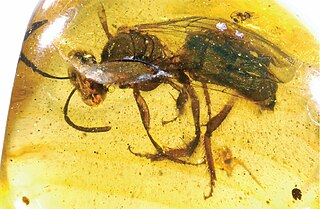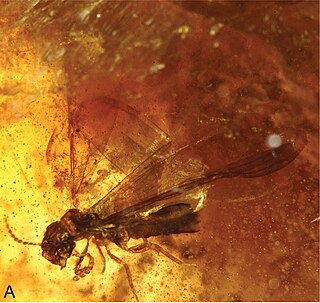
The Stephanidae, sometimes called crown wasps, are a family of parasitoid wasps placed in the superfamily Stephanoidea, which has at least 345 living species in 11 genera. The family is considered cosmopolitan in distribution, with the highest species concentrations in subtropical and moderate climate zones. Stephanidae also contain four extinct genera described from both compression fossils and inclusions in amber.

Oligochlora is an extinct genus of sweat bee in the Halictidae subfamily Halictinae. The genus currently contains six species, all of which are known from the early Miocene Burdigalian stage Dominican amber deposits on the island of Hispaniola.

Aspidopleura is an extinct monotypic genus of parasitic wasp in the Eupelmidae subfamily Neanastatinae and at present, it contains the single species Aspidopleura baltica. The genus is solely known from the Early Eocene Baltic amber deposits in the Baltic Sea region of Europe.

Plumalexius is a genus of wasps in the extinct monotypic family Plumalexiidae, containing two species: the type species Plumalexius rasnitsyni, known from the Late Cretaceous White Oaks Pit in Sayreville, New Jersey, and Plumalexius ohmkuhnlei, known from the Cretaceous Burmese amber.

Diochus electrus is an extinct species of rove beetle in genus Diochus, the only definitive fossil species in subfamily Staphylininae. The species is known only from the middle Eocene, Lutetian stage Baltic amber found in the Blaue Erde deposits, Baltic region, Northern Europe.
Lebanoraphidia is an extinct genus of snakefly in the family Mesoraphidiidae. The genus is solely known from Cretaceous, Upper Neocomian, fossil amber found in Lebanon. Currently the genus is composed of a single species Lebanoraphidia nana.

Astreptolabis is an extinct genus of earwig in the Dermaptera family Pygidicranidae known from a group of Cretaceous fossils found in Myanmar. The genus contains two described species, Astreptolabis ethirosomatia and Astreptolabis laevis and is the sole member of the subfamily Astreptolabidinae.

Tytthodiplatys is an extinct genus of earwig in the family Diplatyidae known from a Cretaceous fossil found in Myanmar. The genus contains a single described species, Tytthodiplatys mecynocercus.

Arostropsis is an extinct genus of broad-nosed weevil in the beetle family Curculionidae known from an Upper Eocene fossil found in Europe. The genus contains a single described species, Arostropsis groehni.
Protostephanus is an extinct genus of crown wasp in the Hymenoptera family Stephanidae known from an Eocene fossil found in the United States of America. The genus contains a single described species, Protostephanus ashmeadi placed in the stephanid subfamily Stephaninae.
Zophotermes is an extinct genus of termite in the Isoptera family Rhinotermitidae known from two Eocene fossils found in India. The genus contains a single described species, Zophotermes ashoki placed in the subfamily Prorhinotermitinae.

Nanotermes is an extinct genus of termites in the Isoptera family Termitidae known from only one Eocene fossil found in amber of the Cambay Basin. The genus contains a single described species, Nanotermes isaacae placed tentatively in the subfamily Termitinae.

Parastylotermes is an extinct genus of termite in the Isoptera family Stylotermitidae known from North America, Europe, and India. The genus contains five described species, Parastylotermes calico, Parastylotermes frazieri, Parastylotermes krishnai, Parastylotermes robustus, and Parastylotermes washingtonensis.
Termitaradus dominicanus is an extinct species of termite bug in the family Termitaphididae known from a Miocene fossil found on Hispaniola. T. dominicanus is the third species in the genus Termitaradus to have been described from fossils found in Dominican amber after Termitaradus avitinquilinus and Termitaradus mitnicki.
Termitaradus avitinquilinus is an extinct species of termite bug in the family Termitaphididae known from several possibly Miocene fossils found in the Dominican Republic. T. avitinquilinus is the first species in the genus Termitaradus to have been described from fossils found in Dominican amber and is one of four species from New World amber, the others being Termitaradus protera, Termitaradus dominicanus and Termitaradus mitnicki.
Zigrasolabis is an extinct genus of earwig in the family Labiduridae known from Cretaceous fossils found in Myanmar. The genus contains a single described species, Zigrasolabis speciosa.
Toxolabis is an extinct genus of earwig in the dermapteran family Anisolabididae known from a Cretaceous fossil found in Burma. The genus contains a single described species, Toxolabis zigrasi.

Gyaclavator is an extinct genus of lace bug in the family Tingidae known from a fossil found in North America. The genus contains a single species, Gyaclavator kohlsi.
Stylotermitidae is a family of termites in the order Blattodea. There are two extinct and one extant genera in Stylotermitidae, with more than 50 described species.











